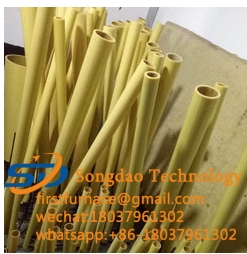- 10
- Jan
What are the technical specifications for the outer coating of epoxy glass fiber pipe?
What are the technical specifications for the outer coating of epoxy glass fiber pipe?
1) The ratio of strength to modulus is high. Specific strength and specific modulus refer to the strength of the material and the ratio of modulus to density. The higher the specific strength, the smaller the weight of the part. The higher the specific modulus, the higher the rigidity of the part. Therefore, the need for high-speed operation of structural components or reduction of transportation weight is of great significance.

2) The interface between the fiber and the matrix in the fiber reinforced composite material can effectively prevent the propagation of fatigue cracks, and the external load is borne by the reinforced fiber. The fatigue strength limit of most metal materials is 30%~50% of its tensile strength, while the fatigue strength limit of composite materials is 60%~80%
3) Adding a small amount of chopped carbon fiber to thermoplastics can greatly improve its wear resistance, and its addition time can be several times longer. For example, carbon fiber reinforced PVC is 3.8 times of its own, PTFE is 3 times of its own, polypropylene is 2.5 times of its own, polyamide is 1.2 times of its own, and polyester is 2 times of its own. Times. By using a suitable composite material of plastic and steel plate, it can be used as a wear-resistant material, such as a bearing material. The three-layer composite material with polytetrafluoroethylene (or polyoxymethylene) as the surface layer and porous bronze and steel plate as the inner layer can be made into excellent materials for sliding bearings.
4) Excellent chemical stability. Fiber-reinforced phenolic plastics can be used in acidic media containing chloride ions for a long time. Using glass fiber reinforced plastics, chemical pipes, pumps, valves and containers that are resistant to strong acids, salts, esters and certain solvents can be made. If the alkali-resistant fiber is mixed with plastic, it can also be used in a strong alkali medium. Alkali-resistant fibers can be used to replace steel and cement composite materials.
5) High temperature ablation resistance. Except for low melting point (900°C) and low melting point (700°C) composite materials, they are usually reinforced with metal fibers. For example, when carbon fiber or boron fiber is used as a reinforcing material, the strength and modulus at 400° C. can be basically maintained at room temperature levels. The same carbon fiber reinforced nickel not only reduces the density, but also has a high temperature function. FRP has extremely low thermal conductivity and instantaneous ultra-high temperature performance, so it can be used as an anti-ablation material.
6) Good technology and planning. By adjusting the shape, layout and content of the reinforcing material, the strength and rigidity of the components can be met, and the materials and components can be formed at one time, thereby reducing the number of parts, fasteners and joints, and greatly improving the strength of the parts. Material utilization.
